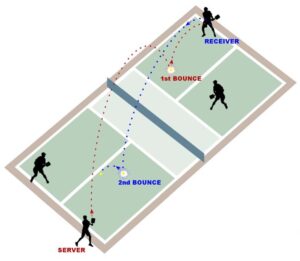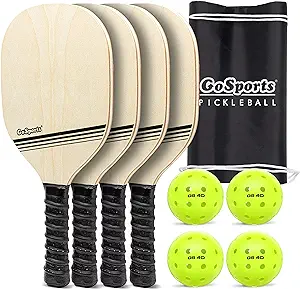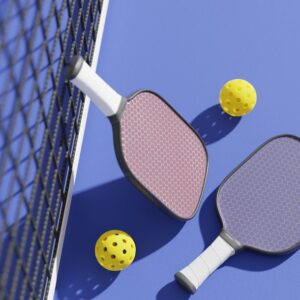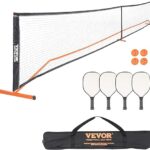What are the basic rules of pickleball?
Pickleball is a fun sport that’s growing in popularity all the time. If you’re curious about this game, or you’re looking for a way to get into shape, then it’s important to learn the basic rules.
In this article, we’ll walk you through the basic rules of pickleball. We’ll explain how to play, what the different positions are, and how to score points. Plus, we’ll give you a few tips on how to improve your game.
So, whether you’re a beginner or an experienced player, read on for everything you need to know about the basics of pickleball.
Table Of Content.
- What is Pickleball?
- Pickleball Rules
- Pickleball Equipment
- Strategies for Winning at Pickleball
What is Pickleball?
What is Pickleball?
Pickleball is a popular racquet sport that combines elements of tennis, badminton, and ping pong. It is played on a court that is similar in size to a badminton court, with a net that is positioned at the center. The game can be played as singles or doubles, and the objective is to hit a perforated ball over the net, aiming to land it within the boundaries of the opponent’s court.
The History of Pickleball
Pickleball was invented in the mid-1960s by Joel Pritchard, Bill Bell, and Barney McCallum, three dads who were looking for a way to entertain their families. They improvised the game using ping pong paddles, a whiffle ball, and a badminton court. The name “pickleball” supposedly came from the Pritchard family dog named Pickles, who would chase after the errant balls during the early stages of the game.
The Basics of Pickleball
Pickleball can be played indoors or outdoors on a variety of surfaces. The court is divided into two halves by a net, and each side has a kitchen area, which is a non-volley zone. The game starts with a serve, and players must hit the ball over the net, allowing it to bounce once on their side before hitting it back. The rally continues until a fault is committed, such as hitting the ball out of bounds or into the net.
💡 key Takeaway: Pickleball is a racquet sport that combines elements of tennis, badminton, and ping pong. It was invented in the 1960s and is played on a court divided by a net, with the objective of hitting the ball over the net and into the opponent’s court while following specific rules and guidelines.
The History of Pickleball
The History of Pickleball
Pickleball, a popular racquet sport, was created in 1965 by three friends named Joel Pritchard, Bill Bell, and Barney McCallum. The game was born out of the desire to keep their families entertained. According to their recollection, they improvised the game by utilizing a badminton court, lowered badminton nets, and handmade wooden paddles. The first pickleball game was played in Pritchard’s backyard on Bainbridge Island, Washington.
The name “pickleball” has an interesting origin. It is believed to have been derived from the Pritchards’ family dog, Pickles, who would often chase after the ball and run off with it. Consequently, the dog’s name became synonymous with the new sport, and the game was eventually named “pickleball.”
Pickleball gained popularity quickly, and by the 1970s, it had spread throughout the United States, primarily through recreational centers, retirement communities, and schools. In 1976, the first known pickleball tournament was held in Tukwila, Washington, attracting players from all over the country.
As the sport continued to grow, organizations such as the USA Pickleball Association (USAPA) were formed to establish official rules and regulations. Today, pickleball is played on dedicated courts with specific dimensions, and it has become an inclusive and competitive sport enjoyed by people of all ages and skill levels.
💡 key Takeaway: Pickleball was created in 1965 as a backyard game and has since developed into a widely popular sport played on dedicated courts. The sport’s name, “pickleball,” was inspired by a family pet.
The Basics of Picklebal
The Basics of Pickleball
Pickleball is a paddle sport that combines elements of tennis, badminton, and ping pong. It is played on a court that is similar in size to a doubles badminton court and is divided by a net. The game can be played indoors or outdoors and is suitable for players of all ages and skill levels.
The History of Pickleball
Pickleball was invented in 1965 by three friends – Joel Pritchard, Bill Bell, and Barney McCallum – who wanted to create a new game for their families to enjoy. The game was originally played in Pritchard’s backyard on a small court with improvised equipment. The name “pickleball” is said to have come from the Pritchards’ dog, Pickles, who would chase after the ball and run off with it.
To play pickleball, players use a paddle to hit a plastic ball over the net and into the opponent’s court. The ball must clear the net and land within the designated boundaries of the court. The game can be played in singles or doubles format, with two or four players on the court respectively.
Pickleball Rules
– Court Size and Dimensions: A pickleball court is 20 feet wide by 44 feet long for doubles play and 20 feet wide by 22 feet long for singles play. The court is divided in the middle by a 34-inch high net.
– Scoring Rules: Pickleball uses a rally scoring system, which means points can be scored by both the serving and receiving teams. A game is typically played to 11 points, and the winning team must win by at least two points.
– Service Rules: The ball is served underhand diagonally, similar to in tennis. The server must stand behind the baseline and serve to the opposite diagonal box. The serve must clear the net and land within the appropriate service court.
Pickleball Equipment
– Paddles: Pickleball paddles are solid, usually made of wood or composite materials. They are slightly larger than a ping pong paddle but smaller than a tennis racket. Paddles come in various sizes and weights to suit different playing styles.
– Balls: Pickleballs are lightweight, perforated plastic balls. They have a similar size and appearance to a wiffle ball, but with smaller holes. Pickleballs come in different colors, with yellow being the most commonly used
Pickleball Rules
Pickleball Rules
When playing pickleball, it’s important to understand the rules to play the game with confidence and enjoyment. Here are the basic rules of pickleball:
1. Court Size and Dimensions:
– The pickleball court is similar in size to a badminton court, measuring 20 feet wide and 44 feet long.
– The court is divided into two halves by a net that is 36 inches high at the sidelines and 34 inches high at the center.
– The non-volley zone, also known as the “kitchen,” is a seven-foot area on both sides of the net where players are not allowed to step in or volley the ball.
2. Scoring Rules:
– Pickleball is typically played as doubles (two players on each side), and the game is played to 11 points.
– Only the serving team can score points, and a team must win by a margin of two points.
– The serving team will serve from the right-hand side of the court, and each player will have the opportunity to serve before the serve is rotated to the opposing team.
3. Service Rules:
– The serve must be hit underhand and made diagonally across the net to the opponent’s service court.
– The serve must clear the non-volley zone and land in the opponent’s service court.
– If the serve hits the net and lands in the opponent’s service court, it is called a “let” and is replayed.
These are just a few of the basic rules of pickleball. Understanding these rules will provide a solid foundation for playing the game correctly and enjoying the experience.
💡 key Takeaway: Familiarize yourself with the court dimensions, scoring rules, and service rules to play pickleball with confidence and abide by the game’s guidelines.
Court Size and Dimensions
Court Size and Dimensions:
In order to play pickleball, it is essential to have a proper court that meets the standard size and dimensions. The dimensions of a pickleball court are similar to those of a doubles badminton court. The court is rectangular in shape and measures 20 feet wide by 44 feet long.
The court is divided into two equal halves by a net, which is hung at a height of 36 inches at the ends and 34 inches in the middle. The net stretches across the entire width of the court, with a height of 34 to 36 inches at the posts.
There are also specific markings on the court that players need to be aware of. The entire court is divided into four quadrants, with a non-volley zone (also known as the kitchen) located on both sides of the net. The non-volley zone extends 7 feet from the net on each side and prohibits players from volleying the ball while inside this zone.
To ensure fair play, it is crucial to have the correct court dimensions and markings to establish a level playing field for all players. By following these court size and dimension guidelines, players can confidently enjoy pickleball knowing that they are abiding by the rules and playing on a proper court.
💡 key Takeaway: Understanding the court size and dimensions is essential to playing pickleball and ensures fair play amongst all participants.
Scoring Rules

Scoring Rules:
In pickleball, scoring follows a unique system that can sometimes be confusing for beginners. The basic scoring rules are as follows:
1. Rally Scoring: In pickleball, points can be scored by both the serving team and the receiving team. Unlike traditional scoring systems, there is no “side-out” or change of serve when a point is scored.
2. First to 11: A game of pickleball is typically played to 11 points, although some variations may use 15 or 21-point games. The winning team must have a two-point advantage to win the game.
3. Serving Order: The serving order is determined at the beginning of the game and remains the same throughout. In doubles play, each team has two serving turns before the serve is switched to the opponents. In singles play, the server serves from the right-hand court when their score is even and from the left-hand court when their score is odd.
4. The Non-Volley Zone: Also known as the “kitchen,” the non-volley zone is the area closest to the net where players are not allowed to hit the ball in the air (volley) unless the ball first bounces. If a player steps into this zone and hits the ball before it bounces, it results in a fault and the opposing team is awarded a point.
5. Faults: In addition to stepping into the non-volley zone, there are several other instances that can result in a fault, such as failing to serve the ball into the diagonal service court, hitting the ball out of bounds, or making contact with the net.
Remember, pickleball scoring can be complex, especially for beginners. It is important to familiarize yourself with the rules and consult an official rulebook for complete and up-to-date information.
💡 key Takeaway: Pickleball scoring follows a unique system called rally scoring, where both serving and receiving teams can score points. The game is typically played to 11 points, and the winning team must have a two-point advantage. Pay close attention to the non-volley zone and avoid committing faults to ensure fair play.
Service Rules
Service Rules:
In pickleball, the service rules are an important aspect of the game. Understanding and following these rules is essential for fair play and maintaining the flow of the game. Here are the key service rules in pickleball:
1. Underhand Serve:
– Players must use an underhand motion to serve the ball.
– The ball should be struck below the waist level.
– The paddle must make contact with the ball below the server’s waist.
2. Right Court, Right Server:
– The server must stand behind the baseline and serve from the right-hand court.
– A player serves diagonally across the court, starting from the right corner of their own court to the opponent’s diagonal court.
3. One Serve Attempt:
– Each player gets only one attempt to serve the ball into the opponent’s court.
– If the serve is unsuccessful, it results in a sideout, giving the opposing team the opportunity to serve.
4. No Foot Faults:
– To avoid a foot fault, the server must have both feet behind the baseline when serving.
– Stepping on or beyond the baseline during the service motion is considered a foot fault and will result in a fault.
5. Crosscourt Serve:
– The serve must be made diagonally across the court.
– The ball must clear the non-volley zone (also known as the kitchen) and land in the opposite diagonal court to be considered valid.
6. Receiver’s Position:
– The receiver must stand outside the non-volley zone until the serve is struck.
– Once the serve is made, the receiver can move into the non-volley zone and play the ball.
💡 key Takeaway: Service rules in pickleball require players to use underhand serves, stand in the correct court, and follow specific guidelines to ensure fair play and an enjoyable game.
Pickleball Equipment

Pickleball Equipment
When it comes to playing pickleball, having the right equipment is essential. Here are the key components of pickleball equipment that every player should be familiar with:
1. Paddles: Pickleball paddles are similar to oversized ping pong paddles. They are usually made of lightweight materials such as graphite or composite and have a honeycomb core for better control and power. The grip of the paddle should provide comfort and stability, allowing players to maintain a firm hold during intense rallies.
2. Balls: Pickleballs are unique compared to other racquet sports balls. They are made of a durable plastic material with smaller holes, which helps to slow down the speed of the ball and enhance control. The color of the balls can vary, but most commonly, yellow is used for outdoor play, and white is used for indoor play. The quality of the ball can significantly affect the gameplay, so it’s important to choose high-quality balls for a consistent and enjoyable experience.
3. Nets: The pickleball net is similar to a tennis net but slightly lower at the center. The regulation height at the center is 34 inches, which allows for a more accessible game. The width of the net should be consistent with the court dimensions. Portable net systems are available for easy setup and play in various locations.
💡 key Takeaway: Having the right pickleball equipment, including paddles, balls, and nets, is crucial for an enjoyable and successful game.
Paddles
Paddles:
When it comes to playing pickleball, having the right paddle is essential. Pickleball paddles are typically made of lightweight materials such as graphite, composite, or wood. They have a solid face with small holes and a grip similar to that of a tennis racket. Here are some key factors to consider when choosing a pickleball paddle:
1. Weight: Paddles come in various weights, ranging from as light as 6-7 ounces to as heavy as 12-14 ounces. The ideal weight for a paddle depends on personal preference and play style. Lighter paddles offer more maneuverability, while heavier paddles provide more power.
2. Grip Size: Paddle grips come in different sizes – typically small, medium, or large. The right grip size is crucial for comfort and control. A grip that is too small can lead to hand fatigue, while a grip that is too big may result in a lack of dexterity.
3. Core Material: Paddle cores can be made of either polymer or aluminum. Polymer cores provide a softer feel and are ideal for beginners and players who prefer a more forgiving paddle. Aluminum cores, on the other hand, offer greater power and control for advanced players.
4. Surface Texture: Paddle surfaces can be textured or smooth. Textured surfaces provide more spin and control, while smooth surfaces offer a consistent ball response. The choice between the two depends on personal preference and playing style.
When selecting a pickleball paddle, it’s important to try out different options, if possible, to find the one that feels comfortable and suits your playing style best. Remember, the right paddle can make a significant difference in your performance on the pickleball court.
💡 key Takeaway: Choosing the right pickleball paddle is crucial for optimal performance. Consider factors such as weight, grip size, core material, and surface texture when selecting a paddle that suits your playing style and preference.
Balls

Balls:
When it comes to pickleball, the type of ball used is crucial. The official ball for pickleball is a unique, perforated plastic ball. These balls are designed to have a slower speed than traditional tennis balls, allowing players to have better control and longer rallies. Pickleball balls are available in different colors, with the most common colors being yellow and white.
– Durability: Pickleball balls are constructed to withstand the impact and wear of the game. They are designed to be durable and last for an extended period of time, even with frequent use.
– Size and Weight: Pickleball balls are slightly larger than a golf ball, with a diameter of approximately 2.87 inches. They are lightweight, weighing around 0.88 ounces. This size and weight are specifically chosen to ensure optimal playability and balance on the court.
– Noise Level: Pickleball balls are created with noise reduction in mind. The perforated design of the balls helps to minimize the noise produced during play, making pickleball a more enjoyable and less disruptive sport, especially in residential areas.
– Bounce and Control: The unique design of pickleball balls, with their precise number and distribution of holes, provides consistent bounce and allows players to have better control over their shots. This feature helps players to develop their skills and enhance their playing experience.
– USAPA Approved: To ensure fair play and standardization, it is recommended to use balls that are USAPA (USA Pickleball Association) approved. These balls meet the specific requirements and standards set by the governing body of the sport.
Using the right balls is essential for a successful pickleball game. Whether you are a beginner or an advanced player, investing in high-quality pickleball balls will enhance your playing experience and ensure fair and enjoyable matches.
💡 key Takeaway: The right pickleball balls, with their specific size, weight, and perforated design, are crucial for optimal playability, control, and durability on the court. Investing in USAPA approved balls will ensure fair play and a more enjoyable game experience.
Nets
Nets
In pickleball, the net plays a crucial role in dividing the court and setting the boundaries for gameplay. Here are some important details about pickleball nets:
Net Height: According to the official pickleball rules, the net should be positioned at a height of 36 inches (91.4 cm) at the sidelines and 34 inches (86.4 cm) in the center. This slight height difference allows the ball to bounce over the net consistently.
Net Width: The width of the net should measure 20 feet (6.1 meters) overall, and it should extend to a height of at least 30 inches (76.2 cm) on each side of the court to prevent the ball from going around the net.
Mesh & Tension: Pickleball nets typically have a mesh material that is designed to be thin enough to allow the ball to pass through, but also sturdy enough to withstand the force of the ball hitting it. The net must be pulled tightly to ensure it maintains the proper height and stability during play.
Key Factors to Consider: When selecting a pickleball net, there are a few factors to keep in mind. Look for a net that is made from durable materials, such as nylon or polyester. It’s also important to choose a net that is easy to set up and take down, especially if you plan on playing in different locations. Lastly, check for any additional features like adjustable tension systems or built-in scoring devices.
Quote: “The net is a pivotal component in pickleball, as it not only separates the court but also determines the height and width specifications for fair gameplay.” – [Source]
💡 key Takeaway: The pickleball net must be set at a specific height and width to ensure a fair game. It should be made of durable materials and be easy to set up and take down for convenience.
Strategies for Winning at Pickleball
Strategies for Winning at Pickleball
Knowing Your Opponent:
Understanding your opponent’s strengths and weaknesses is crucial in developing a winning strategy. Observe their playing style, shot selection, and court positioning. Are they more aggressive or defensive? Do they have a strong backhand or forehand? Armed with this knowledge, you can adjust your game plan accordingly, exploiting their weaknesses and capitalizing on their vulnerabilities.
Using Spin:
Mastering spin is a valuable skill in pickleball. Utilizing topspin, backspin, and sidespin can add variety and unpredictability to your shots. For example, adding topspin to your shots can make them bounce higher and more challenging to return. Practice different spins during drills and friendly matches to hone your skills and keep your opponents guessing.
Choosing the Right Paddle:
Your choice of paddle can greatly impact your gameplay. Consider factors such as paddle weight, grip size, and material when selecting the ideal one for you. Lighter paddles tend to be more maneuverable, while heavier ones offer increased power. Grips come in various sizes, so find one that offers a comfortable and secure hold. Additionally, paddles are made from different materials, such as graphite or composite, each offering its own unique playing characteristics. Experiment with different paddles to find the one that suits your style and enhances your performance.
💡 key Takeaway: To increase your chances of winning at pickleball, take time to observe and analyze your opponents, practice and master different types of spin, and select a paddle that suits your playing style.
Knowing Your Opponent
In order to increase your chances of winning at pickleball, it’s important to have a good understanding of your opponent’s playing style and strategies. Here are some key points to consider when it comes to knowing your opponent:
1. Observe their playing techniques: Watch how your opponent moves on the court, their shot selection, and their overall playing style. Are they aggressive or defensive? Do they prefer dinking or smashing? Observing these details can help you anticipate their shots and adjust your game accordingly.
2. Analyze their strengths and weaknesses: Pay attention to your opponent’s strengths and weaknesses. Do they have a powerful serve? Are they skilled at playing at the net? Identifying their strong points and areas of vulnerability can guide your strategy during the game.
3. Study their shot patterns: Notice the patterns in your opponent’s shots. Do they tend to hit cross-court or down the line? Are they more comfortable with forehand or backhand shots? Understanding their shot patterns can help you position yourself better on the court and be prepared for their next move.
4. Adapt your game plan: Once you have gathered information about your opponent, it’s time to adapt your game plan accordingly. If they have a strong backhand, for example, you might focus on attacking their forehand side. If they struggle with lobs, you can incorporate more overhead smashes into your strategy. By tailoring your approach to your opponent’s weaknesses, you can gain a competitive edge.
Remember, knowing your opponent is not about underestimating or undermining them, but rather using strategic insights to enhance your own performance. Emphasize adaptability and flexibility in your gameplay, and never underestimate the power of observation and analysis.
💡 key Takeaway: In order to improve your chances of winning at pickleball, take the time to observe and study your opponent’s playing style, strengths, weaknesses, and shot patterns. Adjust your game plan accordingly to maximize your chances of success.
Using Spin:
In pickleball, mastering the art of spin can give you a competitive edge on the court. By using spin effectively, you can control the trajectory and direction of the ball, making it more challenging for your opponents to return. Here are some key strategies for incorporating spin into your pickleball game:
1. Spin serves: When serving, try adding spin to your shots to catch your opponent off guard. A slice serve, where you brush the paddle across the ball’s side to create side spin, can make the ball curve away from your opponent, making it difficult to return.
2. Topspin shots: To add topspin to your shots, brush the paddle up the backside of the ball during contact. This will cause the ball to spin forward and dive downward once it crosses the net. Topsin shots can be great for putting pressure on your opponent and forcing them to make difficult returns.
3. Slice shots: A slice shot involves brushing the paddle diagonally across the backside of the ball during contact. This imparts side spin on the ball, causing it to curve in the air. Slice shots can be particularly effective when returning volleys or aiming for the sidelines, as the spin makes it harder for your opponent to anticipate the ball’s trajectory.
Remember, practice is key when it comes to mastering spin in pickleball. Take the time to develop your technique and experiment with different spin variations to keep your opponents on their toes.
“Spin shots are a valuable weapon in pickleball, allowing players to take control of the game and keep their opponents guessing.”
💡 key Takeaway: Incorporating spin into your pickleball game can give you a competitive advantage, whether it’s through spin serves, topspin shots, or slice shots. Practice different variations of spin to keep your opponents guessing and improve your chances of winning.
Choosing the Right Paddle
Choosing the Right Paddle
When it comes to playing pickleball, choosing the right paddle is crucial. Your paddle is like an extension of your arm, and finding the right one can greatly enhance your performance on the court. Here are some factors to consider when selecting a pickleball paddle:
1. Weight: Paddles come in a range of weights, typically ranging from 6 to 14 ounces. The weight of a paddle affects the power and control you have over your shots. Lighter paddles offer more maneuverability and control, while heavier paddles provide more power.
2. Grip Size: The grip size of the paddle determines how comfortably it fits in your hand. Paddles usually come in sizes ranging from 4″ to 4 ½”. It’s important to choose a grip size that feels comfortable and allows you to maintain a firm hold on the paddle.
3. Material: Pickleball paddles are commonly made from three main materials: wood, composite, and graphite. Wooden paddles are more beginner-friendly and offer good control, but they are heavier and less durable. Composite paddles are a popular choice, offering a balanced combination of power, control, and durability. Graphite paddles are lightweight and offer excellent control and power, but they may be more expensive.
4. Paddle Face: The face of the paddle can have different textures, such as smooth or rough. A rough surface can help add spin to your shots, while a smooth surface provides a consistent and predictable ball response.
Remember, the best paddle for you ultimately depends on your skill level, playing style, and personal preferences. It’s a good idea to try out different paddles before making a final decision.
💡 key Takeaway: Choosing the right paddle is essential for maximizing your performance in pickleball. Consider factors such as weight, grip size, material, and paddle face texture when selecting a paddle that suits your playing style and prefere

